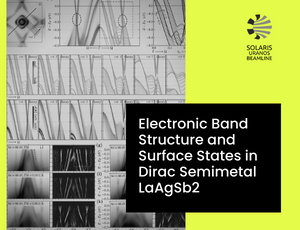
 Web Content Display
Web Content Display
SOLARIS centre
 Web Content Display
Web Content Display
 Web Content Display
Web Content Display
Nontrivial electronic structure of Dirac semimetal

Researchers at the SOLARIS Centre have conducted high-resolution ARPES measurements of Dirac semimetal, a material with a unique electron structure. The Dirac semimetals are three-dimensional crystals consisting of layers with different properties, with potential applications in modern electronics. The authors of the publication confirmed theoretical predictions experimentally, among other things, they observed the linear nature of individual bands and nodal lines associated with the symmetry of the system.
Dirac semimetals
Graphene and topological insulators are two materials that are generating tremendous interest in the new materials market. Now Dirac semimetals have joined the forefront. All these materials have interesting physical properties, their electron structure is unique, and they provide room for many new discoveries.
Nodal Dirac semimetals are materials that, from an electronic structure point of view, can be understood as a three-dimensional analog of graphene. In graphene, as in semimetals, one can find Dirac points. Discrete Dirac points are formed at the crossings of the conduction and valence bands. Examples of such a compound are Na3Bi and Cd3As2.
Interesting electron structure of LaAgSb2
Reading previous publications on the compound LaAgSb2, which is a Dirac semimetal, SOLARIS scientists became interested in its nontrivial topological character. In cooperation with specialists from the Institute of Nuclear Physics in Krakow, they made theoretical calculations, which they then decided to confirm experimentally. For the study, the authors used the angle-resolved photoelectron spectroscopy (ARPES) technique available on the URANOS beamline. The results obtained are surprising and contradict previous predictions about this compound.
Marcin Rosmus, the first author of the paper, says more about the publication:
"Our experiment supported by theoretical calculations has shown the existence of Dirac nodal lines that result from the symmetry of the system or the disappearance of spin-orbit splitting. Moreover, we showed that the linear bands do not form Dirac surface states, which was confirmed by theoretical calculations performed for different sample surface terminations. Previous predictions for this compound spoke of the existence of a Dirac-like structure near the Fermi level. Our results contradict this."
Link to the publication:
Electronic Band Structure and Surface States in Dirac Semimetal LaAgSb2,
Materials 2022, 15(20), 7168; https://doi.org/10.3390/ma15207168
